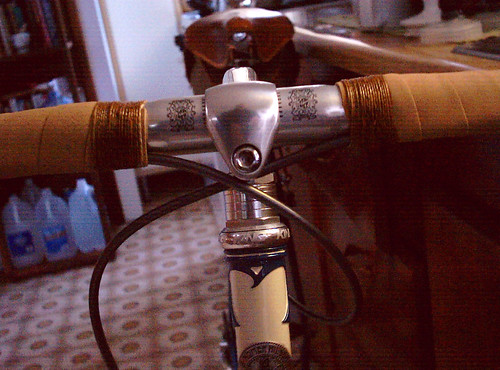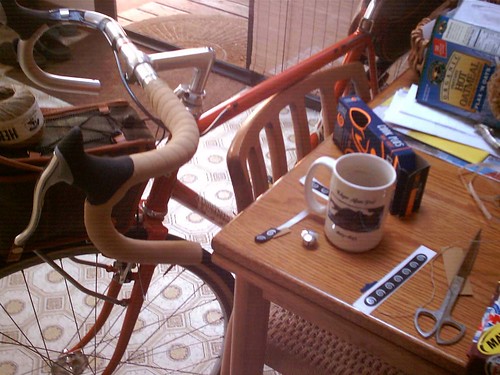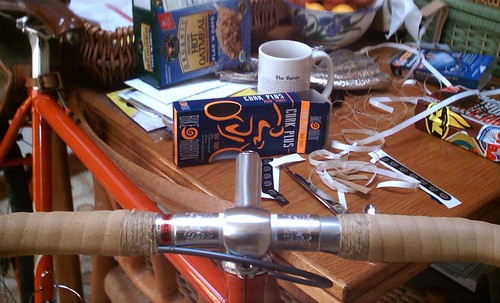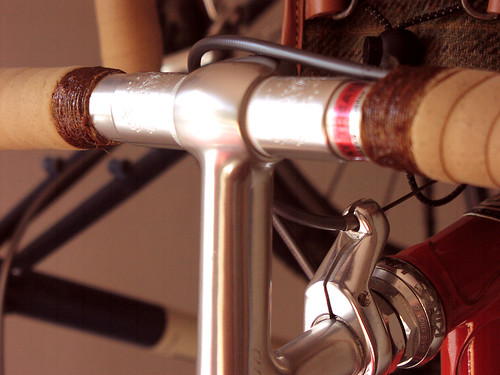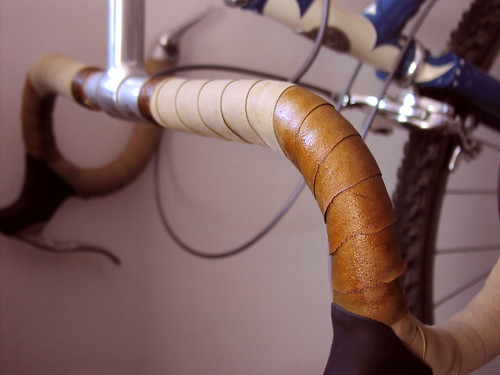My bar tape finishing habits have been bothering me for some time. They began back in my Cinelli cork splash days (oh, come one… we all did it at least once…) when the “Cinelli-Cinelli-Cinelli…” finish wrap tape snapped (again!) just as I applied what should have been an appropriate amount of pressure. The electrician’s tape roll hung on a nail by the shared workbench, and I’d watched my sensei use it quickly and efficiently numerous times, while he would silently shake his head as I snapped my way through the stuff that came in the box. Since the final breakage of the C-tape meant it no longer even made one complete orbit of the bars, I reached for large black roll.
It worked quite quickly, and you could put a boatload of pressure on it. The resulting snap-back of the tape tightened things up even further. From that day forward, it was three and a half wraps of black electrician’s tape. No more tape popping and unravelling from the stem area.
More recently, it just started to seem cheap and tawdry. I’d notice the way it would catch the light and look wrinkled and scrunched. I’d see the adhesive residue creeping out from underneath, and spend more time cleaning up the bars to remove the gunk.
Recently, as the white bar wrap on the Quickbeam became increasingly dishwater grey, I felt it was time to move on. Back when the Hilsen arrived, Mark at Rivendell had finished off the cork wrap with an exceptional twining job:
In the year or so since I’ve had that bike, I’ve realized that you spend a fair amount of time with that general area in your field of vision. The care put into the twined and shellacked wrap tended to bring about a smile.
Honestly, I’ve been shying away from the whole shellac thing. Twining the bar tape seemed a bit like a simple gateway drug. Adding shellac just seemed to change people. It seemed that fine and normal folks would start there, then start wrapping and shellacking all manner of things. Which, in and of itself is fine. But, where do you draw the line? Clearly, I needed some boundries. Or, at least a safe word. Maybe a lacquer-buddy… My wife was starting to work with oil paints again, so we volunteered to watch out for each other.
The twine turned out to be the easy part (although RBW just mentioned that their source may discontinue the product). I just put it on the same order that brought a new chainring recently. Me and 385 feet of hemp twine, hanging out. Cool.
But shellac? Not so simple. Seemed like it should be easy enough to pick up at the chain hardware store near work. Well, only if I wanted a gallon. Or an aerosol spray can.
Nope. I figured that there could be little more dangerous than me armed with propellant-powered shallac. I recently recaulked the tub, using one of those clicky-gun-things. It was ugly. I mean, did you know that you had to pierce another seal after you clipped the tip off of the caulk module?
Local hardware store? No. Another local hardware store? They kept steering me over to the varnish display, and asking rather pointedly why varnish wouldn’t work better, especially since it came in a wide variety of colors and finishes. I think they knew about the hemp. Struck out at the big craft store, a model & hobby shop and Sears. I’d actually peeled the bars over the weekend, and was riding around with gloves and near-naked bars for these errands. It began to recall the recent theme of “Quest for Salmon Canti Kool-Stop Pads“…
Finally, I thought to hit up Marin Color Service - a contractor-oriented paint retailer who always seemed to have lots of cans of stuff on the shelves. A phone call confirmed they had it - both clear and amber - in sizes as small as a half pint.
Turns out they lied, of course. But not badly. I honestly hadn’t expected the clerk to wander out onto the floor the check that they had the smaller sizes, especially since they claimed to stock it, which at least meant they could probably order it. His answer had been so decisive that I hadn’t confirmed that they actually had clear in the little can. So, I had no one to blame but myself upon finding myself staring at a gallon of clear, and many varieties of the amber.
My plan had not been to start with the hard stuff. A clear sheen on some twine might mean wax or some sealant, but not necessarily shellac. The rich roasted color of the amber was a definite sign that I was using, similar to the Mentats. There was no turning back. They also gave me a free paint can opener.
Despite knocking the twine ball off its perch, chasing it across the floor and then figuring I had plenty of twine already pulled out only to find myself two wraps short (not enough tag end to do the nifty whip finish), things came together pretty well. I could put the kind of pressure on the turns that I’d only dreamed of with tape. The whip finish worked perfectly. The twine wraps were not specifically symmetrical, but close enough not to be offensive, while being different enough to be interesting.
Because it was Saturday, the weather silly-gorgeous and definitely time to ride, I neglected the shellac step before heading out onto the roads. But, last night, I broke out the cheap brush, spread a little paper and put a couple coats on the wrap. Here it is in this morning’s light:
In fact, it got me excited enough that I decided to re-coat Mark’s original twining job on the Hilsen. Since the working theory is that the C. Xavier Hilsen will be out on the course this coming weekend, I wanted it to look its best.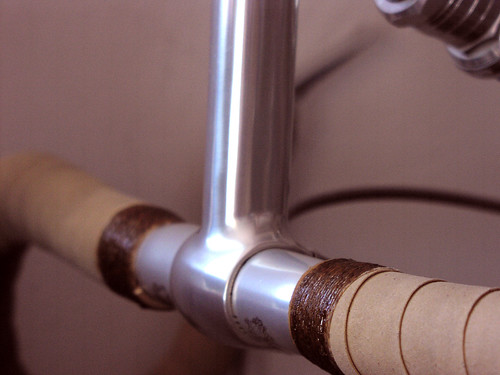
As I considered the bar tape, the fraying at the corners of the ramps worried me a bit. Once that works through, the unravelling begins. Granted, next on the work manifest was the stem replacement on the Hilsen, but in the meantime, I didn’t want to be trailing bar tape. And the shellac was open. And the brush was already dirty. And I knew it would help seal things a bit to resist the wear. And once I started, it looked pretty cool…
Um.. ok.. It may be time for an intervention. Maybe it’s something in the laquer. Once you get that brush in your hand, it’s really, really hard to stop. Let this be a lesson to you all.
